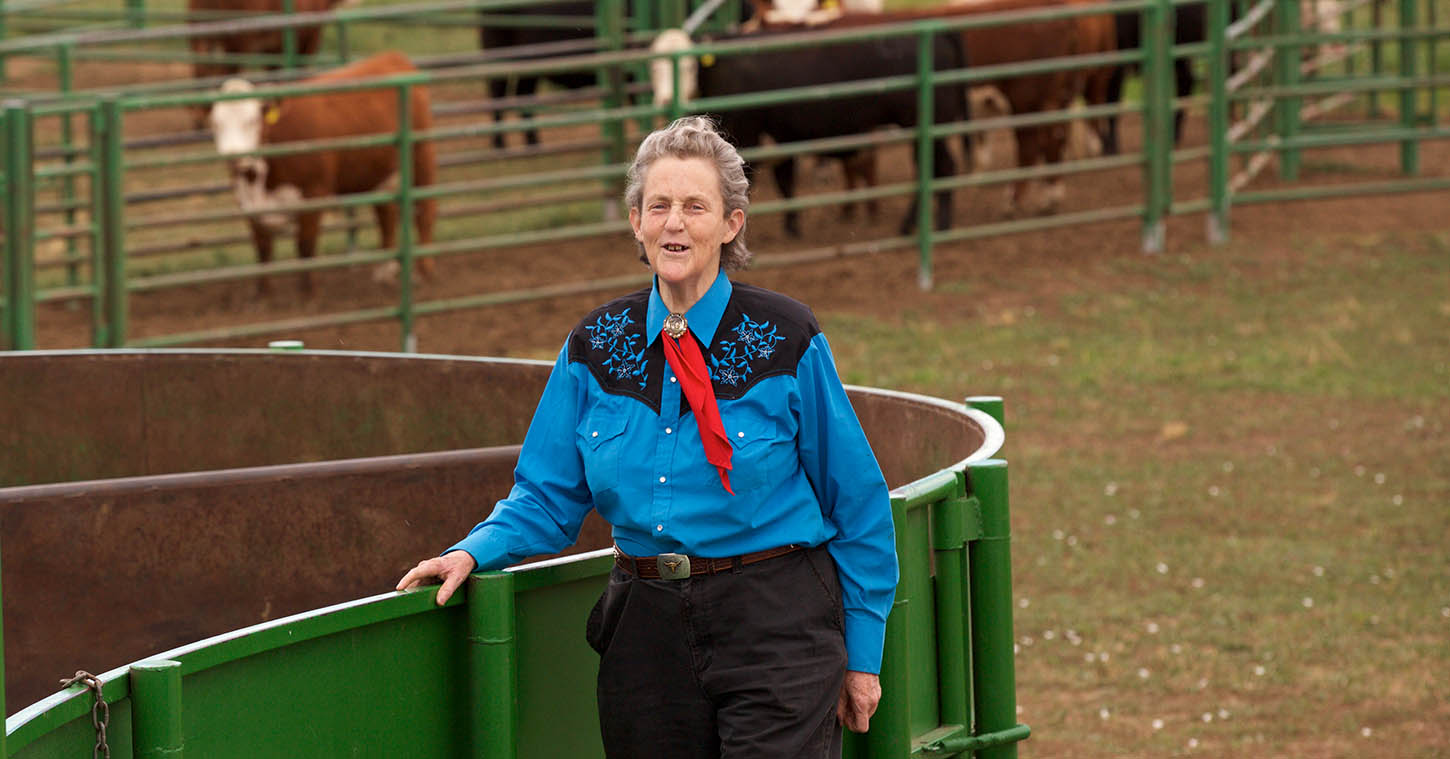Did Temple Grandin produce less or more cruelty in the world?
What does it mean to create a better experience for animals as you lead them to the slaughterhouse? Is it possible?
Most people would not consider what is happening in the slaughterhouse, even remotely ethical. Still, one must admit that there are different levels of cruelty, and a scenario could be less cruel compared to another, even though both methods are horrible.
Temple Grandin is known for her ethical developments in the livestock industry around the world.
If there is a possible way to process animals in an ethical way, we’re very, very far from it. Still, improvements have been made in that direction. One such innovator is Temple Grandin.
Who is Temple Grandin?
Mary Temple Grandin is a consultant within the livestock industry as well as an Autism activist. She is known within the animal science field for her publications on cattle behavior and how they are affected by the meat industry.
Grandin was diagnosed with autism in adulthood and began to relate her autism experiences to animals in slaughterhouse conditions. Because of her autism, she was able to relate her feelings of anxiety and sensory perceptions to the sensitivities of that livestock experience.
Through Grandin’s studies, she has made distinctions about the visual distractions that animals are sensitive to within livestock handling facilities such as shadows, people, and other factors within their holding environments.
If you’re looking to read some of her first publications on the behavior of beef cattle design in from 1980, click here

What Was Grandin’s Impact on Livestock Cruelty?
Temple Grandin had good intentions within the livestock community. Through research in her field of animal science and behavior, she spoke out about the effects of the proper handling of livestock.
Now her message can be seen throughout the industry to reduce stress in animals as they make their way to the slaughterhouse.
Grandin’s goal was to take away the upsetting sensory experiences that invoke panic and distress within the cattle as they are moving toward slaughter.
Through her corporation “Grandin Livestock Handling Systems Inc.”, Grandin had developed technology as well as scoring methods to enhance the slaughterhouse system to become what it is today.
Temple Grandin’s top three developments:
1. Center Track Conveyor Restrainer
The Center Track Conveyor Restrainer is a double rail system that has been developed to fit a variety of animal sizes, from calves to cows. This new development is a fresh take on the standard V restrainer that can cause hemorrhages during the electrical stunning of the cattle before they are ground up and processed.
This conveyor allows for a quiet and compact restraining of the animal that is on its way to slaughter.
The conveyor restraint has a goal of calming animals without agitating them by creating a quiet tunnel into the restraint and leading them peacefully to their death. During this process, people involved in the slaughtering are to remain quiet as to not spook the animal.
2. Curved Cattle Handling System
The Curved Cattle Handling System uses the natural patterns of cattle movement to guide them into cages known as cattle chutes or to other locations such as slaughterhouses and pens.
The Curved Coral is a cattle herding system with a natural curvature design on flat land. The animals enter one end as a herd and exit the other in a single file line to easier handle the individual animals.
Why does this work?
As animals follow the curvature, the animals believe that they are going back to the entrance, not the end toward the chute. The animals are entirely barred off from seeing people at the end of the chute, so they don’t see what they’re going towards. This curved coral system follows the natural behaviors of cattle.
3. Grandin Scoring System
Temple Grandin’s scoring system scores how cattle are being treated at livestock handling plants. The scoring system is used to produce better outcomes amongst meat production facilities.
How Ethical is Livestock Handling Today?
Although Temple Grandin has worked toward relieving the panic that animals experience during handling as they move toward meat production plants, livestock handling is not ethical nor cruelty-free.
Cattle raised for slaughter live stressful lives from the beginning through poor living and feeding conditions. Many animals become sickly from their cramped and tight living circumstances where they cannot often graze freely throughout their lifetime.
Patterns of sickness arise from inadequate hygiene facilities where animals succumb to worms, viruses, and bacteria. To counteract these diseases and loss of livestock profit, animals are pumped with antibiotics to keep them alive long enough to be used for meat.
Emotional trauma takes place in the form of mothers losing their children regularly to supply meat of younger animals such as calves and lambs.
Poorly managed facilities place animals through heat stress and place their lives in danger.

The Other Side of Grandin’s Ethical Methods
Grandin’s message is that animal slaughtering is okay if it is done ethically. She focuses on how to keep an animal calm and reduce panic as they move toward their deaths.
With the technology that she has developed, Temple Grandin aided the meat production industry by cutting down the time it takes to heard cattle and gets them into processing plants.
The only part of the process that has been considered through her developments are the ends of their lives, not the conditions they live in.
What Is Going on Here?
Consider this: through Temple Grandin’s methods of cattle herding for meat production, she has fueled the industry with a more efficient way to mass-produce meat.
Mass meat production has become more efficient through Grandin’s developments. Can livestock that is produced in terrible living conditions truly be ethical?
When done on a large scale, meat production can be cheaper and quicker with technology such as the Center Track Conveyor Restrainer. By creating a briefly calm environment for animals, they are easier to oversee and quicker to kill than squirming and skittish cattle.
Even hearing of these “ethical” circumstances that animals are killed in, censor us from realizing the rest of the cruelty that animals endure.
Coming Back to Reality
Although Grandin’s purpose was to create a less panicked and terrifying experience for animals in their final hours, it allows corporations to shield themselves from attacks on their morals and ethics.
The issue of animal cruelty has not been properly addressed by the mass meat production industry and Temple Grandin’s technology allows for corporations to grow and put animals in grave danger.
The Grand Thing About Grandin
Although the previous statements still weigh heavily in an argument, there are two sides to a story.
Animals will always have a tough time in the meat industry, it’s inevitable. There is no denying that animals, similarly to every other living thing, will die eventually. Temple Grandin had enough knowledge on animal behavior to make the process less scary and nerve-wracking for the animals who were being killed.
Through her own personal insight on animal science and autism, she was able to bring knowledge to the round table. Her developments aided the process and emotions that animals go through during the slaughter process.
Ryan Ruppert, the director of Beef Quality Assurance within National Cattlemen’s Beef Association, appreciates Grandin’s insight on low-stress handling environments for livestock. The Beef Quality Assurance scoring system used by the National Cattlemen’s Beef Association aids in assuring that cattle are properly handled.
Temple Grandin is known to be an advocate for animals as well as animal agriculture as she has worked to improve the management systems in which animals are butchered. With the use of her technological developments, animals can naturally follow their instincts to be guided to meat production rather than forcefully dragged to it.
By following their natural instincts and behaviors, one could argue that it’s no different from the cycle of life. For example, the imitation of regular grazing with the curved cattle herding system would replace the traumatizing herding done to rally up and cage cattle.
By using this technology, cattle no longer have to assume the worse when they see herding commencing. In turn, this leads to calmer livestock who aren’t nervous when humans come to handle them.
Grandin’s ethics don’t stop at livestock handling. Temple Grandin works diligently to prevent meat waste in the industry. She believes that animals can be eaten ethically without the guilt because it is a way of life. However, she does not support the wasting of the meat in anyway or else the animal would have died in vain.
After a hard-hitting expose on pink slime, produced by American Broadcasting Company (ABC), caught the world off guard, the meat industry took a hit. The documented clips explained how much meat consumed on a regular basis is not prime meat. Lean, finely textured beef is consumed by people everywhere, in schools, at restaurants, even at home.
The issue with this beef product came as ABC exposed that this meat is comprised of random beef trimmings that are ground up to become meat fillers to bulk up meat that is sold to eat and referred to as pink slime.

Temple Grandin then stepped in to announce her views that there is nothing wrong with that meat. Furthermore, she pushed that if we in society were to discard “pink slime”, then we would be wasting most of the cow that has been killed to feed us. Grandin viewed the pink slime pushback as an unethical waste of meat.
The 2010 HBO movie Temple Grandin showcases Grandin’s life as an autistic woman who grew to be a leading scientist in the livestock handling industry. The dramatized biopic showcases Grandin in a positive light as a woman who revolutionized practices in the meat industry to move forward with an ethical handling of livestock.
The movie is critically acclaimed and perfect for viewers who want to experience Grandin past the criticism and look at her work for what it was at it’s bare bones.
In the end, it can be difficult to decide what is and is not ethical about the slaughtering of livestock for food on a mass scale. However, can be agreed upon that Temple Grandin changed the meat industry forever.
